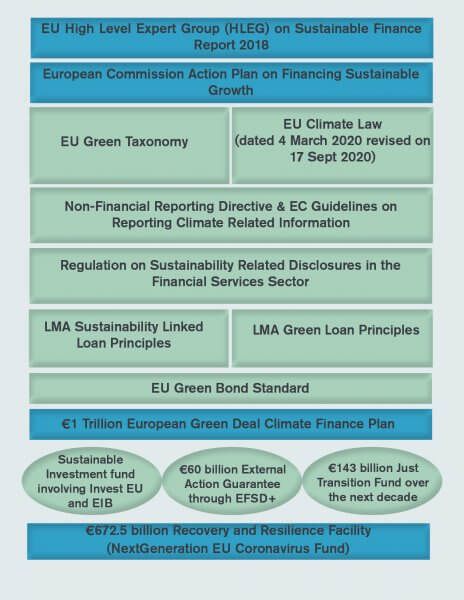Climate Finance Week Ireland 2020 this year takes place against the backdrop of the COVID-19 pandemic. Like a lot of events this year it has moved to a virtual platform but its context has never been so relevant. In the first part of our Philip Lee Green Finance Series we look at the architecture of the EU Green Deal and identify the opportunities and challenges across the financial sector, and Green Finance.
The COVID-19 pandemic has crystallised the economic impact of climate change and biodiversity on a global scale, with its repercussions being felt across health systems and economies globally.
The WHO and IPCC Health Committee have predicted a century of pandemics. A frightening thought given the sudden death toll, health implications and economic disruption caused by COVID-19, a pandemic, caused by pathogen jumping between species as a result of environmental degradation and climate change.
It is predicted that the COVID-19 pandemic will be among a series of climate shocks set to occur as a consequence of climate change across the world, including fires, floods, droughts, typhoons and other negative climate events, evidence of which we have already seen in the last 12 months with the wild fires in California and Australia to mention a few.
The challenge now globally is to build resilience and address the Paris climate targets by reducing greenhouse gas emissions. From a financing perspective it is estimated that nearly 50% of the risk exposures of Euro area institutions, are directly or indirectly linked to risks stemming from climate change1.
In Europe, the European Commission launched the 'European Green Deal' as its roadmap to build a circular, sustainable economy and this has been refocussed on in recent months in the context of COVID-19 (the "Green Deal").
Looking at the strategy and the string of announcements it can be hard to make sense of the various strategies, initiatives and the terminology, not to mention how the strands involved integrate overall.
Targets
In order to meet the net zero 2050 targets of the UN 2030 Agenda, SDGs, and the Paris Agreement, the 2030 targets involve a revised minimum 55% cut in GHG emissions2, 40% renewable energy consumption and 41% renewable energy savings. It is estimated that an additional annual investment of €175 to €290 billion will be required to achieve these targets.
Background to the Green Framework and Initiatives
The European Commission appointed a high level expert group on sustainable finance (HLEG) in 2016 to produce a report and deliver recommendations to develop a roadmap for sustainable finance in Europe. Its final report, delivered in January 2018, and adopted by the Commission, forms the basis of its 'Action Plan, Financing Sustainable Growth'; a lattice work of measures that seek to support the achievement of these targets, underpinned by the Green Deal.
The Green Deal
The Green Deal seeks to mobilise over €1 trillion in
sustainable investment over the next decade to fund transition to
the low carbon economy and facilitate sustainable investment by
private investors and public sector by delivering funding to
support the policy measures, including:
" €503bn funding from the EU budget;
" €114bn national co-financing;
" €279bn through InvestEU;
" €143bn through the Just Transition Fund
The European Commission President, Ursula von der Leyen recently pledged to put the Green Deal at the heart of the COVID-19 stimulus response and announced the EU's 2030 target was being increased from a 40% GHG reduction to a 55% reduction in GHG (compared to 1990 levels). As part of that commitment, a further review of all existing EU climate legislation is underway to reflect this 55% emission reduction target. The EU Recovery and Resilience Facility will contribute an additional €672bn in funding in the context of the Coronavirus recovery stimulus and to support Member States national recovery plans (30% of which is to be set aside for projects to be financed by green debt).
Architecture of the Green Deal

EU Action Plan on Financing Sustainable Growth
The March 2018 action plan sets a goal of embedding sustainability considerations at the heart of the financial sector by:
" Reorienting capital flows towards sustainable
investment;
" Managing financial risks of climate change, resource
depletion, environmental degradation and social issues; and
" Fostering greater transparency and long-termism in
financial/economic activity.
In the next part of our Climate Finance Week Ireland 2020 series we take a look at the EU Taxonomy and how to put the Green in 'Green Finance'.
Footnotes
1 European Commission Action Plan; Financing sustainable growth, March 2018
2 In its 'Communication on Stepping up 2030 Europe's Climate Ambition' [COM(2020) 562 Final 17.09.20], the European Commission recently increased this target to 55%, following which the European Parliament voted in favour of increasing this to a 60% reduction.
Originally published by Philip Lee, November 2020
The content of this article is intended to provide a general guide to the subject matter. Specialist advice should be sought about your specific circumstances.


